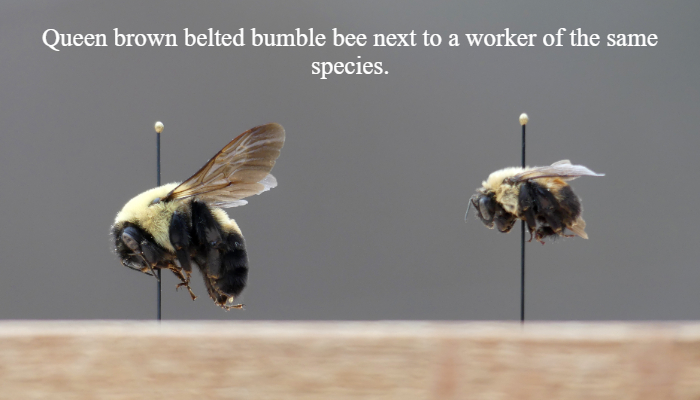Long Live the Queen (Bumble Bee)

Spring is here… technically. It doesn’t always feel like it, but I have been assured that it is, in fact, true. With spring comes the return of my favorite insects, bees. And my favorite among favorites? Bumble bees.
You may have noticed that in early spring the bumble bees you see are especially big. That is because in spring, every bumble bee you see is a queen. Aside from being beautifully (and occasionally alarmingly) large, queen bumble bees are different from other bumble bees in another way. Queens are the only bumble bees that survive the winter. Typically they wait out this sad, flower-less time underground, emerging once again after spring has sprung (if only I could say the same). Since there are no male bumble bees in the spring, queens come prepared, having mated the previous fall. Their objective now? Found a colony.
While one typically encounters bees on flowers, in the spring you may notice queen bumble bees ignoring them altogether, flying low over the ground, stopping to investigate holes and crevices, in search of the perfect place to make their home. For most bumble bees, that’s on or under the ground (abandoned rodent burrows and grassy tussocks are favorites), but some species like their nests higher up and will nest in tree cavities or even occasionally bird houses.
While bumble bees don’t create the same elaborate honeycombs as their European honey bee cousins, they do perform some construction of their own. Using wax produced by glands on her abdomen, a queen in the first steps of founding a new colony will build a little pot in which to store nectar so that she may go undisturbed while she incubates her first set of eggs. The eggs themselves are laid on top of a mixture of pollen and nectar called pollen bread and then the whole thing, eggs included, are sealed in wax to keep everything moist. Check out this video I took of a captive bumble bee constructing a mound on which to lay her eggs. A nectar pot is on the right.
Bumble bees incubate their eggs, vibrating their flight muscles to generate heat to keep the eggs warm. If successful, after a few days the eggs will hatch into larvae and the queen will forage to gather pollen and nectar for them, removing, replacing, and expanding their wax coverings as they grow, until they, like moths, spin cocoons in which to pupate. They will be the colony’s first batch of workers and will help the queen to forage and rear young, though they generally do not lay any eggs of their own. You may note their presence in your garden by their small size. Having only been provided the sustenance that a single queen could provide, they are often quite small and subsequent generations of workers with more hands to feed them will get bigger as the colony grows, the nest itself becoming a somewhat haphazard clump of nectar pots and larval cells. In your garden, it may give the impression that the bumble bees are growing larger as the season wears on but a bee will not grow in size after it has reached its adult form, merely the new bees are larger and the older, smaller bees die off.
When workers become sufficient in number, the queen will no longer be required to venture outside of the nest, and you will not see her again. She will stay in, laying eggs and tending to her young until her death at the end of the season. Don’t be too dismayed however, as a fresh crop of queens will begin to emerge in mid-summer. They will tend to the colony’s needs for a while before leaving to mate and fatten up for hibernation.
The colony’s last act will be to produce males. This is when colony cohesion begins to break down and workers too will occasionally lay eggs (these eggs, being unfertilized, also develop into males). Unlike workers and queens, males do not work in the nest at all and spend all their time nectaring or searching for a mate. But successful or not, the males, as well as the workers and the old queens, all die at the end of the season, leaving the new queens cozy in their underground hibernation spots to wait out the winter.


